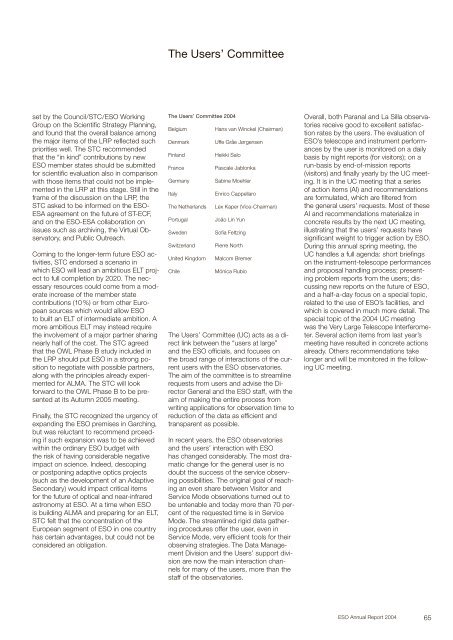ESO Annual Report 2004
ESO Annual Report 2004
ESO Annual Report 2004
- TAGS
- annual
- www.eso.org
You also want an ePaper? Increase the reach of your titles
YUMPU automatically turns print PDFs into web optimized ePapers that Google loves.
set by the Council/STC/<strong>ESO</strong> Working<br />
Group on the Scientific Strategy Planning,<br />
and found that the overall balance among<br />
the major items of the LRP reflected such<br />
priorities well. The STC recommended<br />
that the “in kind” contributions by new<br />
<strong>ESO</strong> member states should be submitted<br />
for scientific evaluation also in comparison<br />
with those items that could not be implemented<br />
in the LRP at this stage. Still in the<br />
frame of the discussion on the LRP, the<br />
STC asked to be informed on the <strong>ESO</strong>-<br />
ESA agreement on the future of ST-ECF,<br />
and on the <strong>ESO</strong>-ESA collaboration on<br />
issues such as archiving, the Virtual Observatory,<br />
and Public Outreach.<br />
Coming to the longer-term future <strong>ESO</strong> activities,<br />
STC endorsed a scenario in<br />
which <strong>ESO</strong> will lead an ambitious ELT project<br />
to full completion by 2020. The necessary<br />
resources could come from a moderate<br />
increase of the member state<br />
contributions (10 %) or from other European<br />
sources which would allow <strong>ESO</strong><br />
to built an ELT of intermediate ambition. A<br />
more ambitious ELT may instead require<br />
the involvement of a major partner sharing<br />
nearly half of the cost. The STC agreed<br />
that the OWL Phase B study included in<br />
the LRP should put <strong>ESO</strong> in a strong position<br />
to negotiate with possible partners,<br />
along with the principles already experimented<br />
for ALMA. The STC will look<br />
forward to the OWL Phase B to be presented<br />
at its Autumn 2005 meeting.<br />
Finally, the STC recognized the urgency of<br />
expanding the <strong>ESO</strong> premises in Garching,<br />
but was reluctant to recommend prceeding<br />
if such expansion was to be achieved<br />
within the ordinary <strong>ESO</strong> budget with<br />
the risk of having considerable negative<br />
impact on science. Indeed, descoping<br />
or postponing adaptive optics projects<br />
(such as the development of an Adaptive<br />
Secondary) would impact critical items<br />
for the future of optical and near-infrared<br />
astronomy at <strong>ESO</strong>. At a time when <strong>ESO</strong><br />
is building ALMA and preparing for an ELT,<br />
STC felt that the concentration of the<br />
European segment of <strong>ESO</strong> in one country<br />
has certain advantages, but could not be<br />
considered an obligation.<br />
The Users’ Committee<br />
The Users’ Committee <strong>2004</strong><br />
Belgium Hans van Winckel (Chairman)<br />
Denmark Uffe Gråe Jørgensen<br />
Finland Heikki Salo<br />
France Pascale Jablonka<br />
Germany Sabine Moehler<br />
Italy Enrico Cappellaro<br />
The Netherlands Lex Kaper (Vice-Chairman)<br />
Portugal João Lin Yun<br />
Sweden Sofia Feltzing<br />
Switzerland Pierre North<br />
United Kingdom Malcom Bremer<br />
Chile Mónica Rubio<br />
The Users’ Committee (UC) acts as a direct<br />
link between the “users at large”<br />
and the <strong>ESO</strong> officials, and focuses on<br />
the broad range of interactions of the current<br />
users with the <strong>ESO</strong> observatories.<br />
The aim of the committee is to streamline<br />
requests from users and advise the Director<br />
General and the <strong>ESO</strong> staff, with the<br />
aim of making the entire process from<br />
writing applications for observation time to<br />
reduction of the data as efficient and<br />
transparent as possible.<br />
In recent years, the <strong>ESO</strong> observatories<br />
and the users’ interaction with <strong>ESO</strong><br />
has changed considerably. The most dramatic<br />
change for the general user is no<br />
doubt the success of the service observing<br />
possibilities. The original goal of reaching<br />
an even share between Visitor and<br />
Service Mode observations turned out to<br />
be untenable and today more than 70 percent<br />
of the requested time is in Service<br />
Mode. The streamlined rigid data gathering<br />
procedures offer the user, even in<br />
Service Mode, very efficient tools for their<br />
observing strategies. The Data Management<br />
Division and the Users’ support division<br />
are now the main interaction channels<br />
for many of the users, more than the<br />
staff of the observatories.<br />
Overall, both Paranal and La Silla observatories<br />
receive good to excellent satisfaction<br />
rates by the users. The evaluation of<br />
<strong>ESO</strong>’s telescope and instrument performances<br />
by the user is monitored on a daily<br />
basis by night reports (for visitors); on a<br />
run-basis by end-of-mission reports<br />
(visitors) and finally yearly by the UC meeting.<br />
It is in the UC meeting that a series<br />
of action items (AI) and recommendations<br />
are formulated, which are filtered from<br />
the general users’ requests. Most of these<br />
AI and recommendations materialize in<br />
concrete results by the next UC meeting,<br />
illustrating that the users’ requests have<br />
significant weight to trigger action by <strong>ESO</strong>.<br />
During this annual spring meeting, the<br />
UC handles a full agenda: short briefings<br />
on the instrument-telescope performances<br />
and proposal handling process; presenting<br />
problem reports from the users; discussing<br />
new reports on the future of <strong>ESO</strong>,<br />
and a half-a-day focus on a special topic,<br />
related to the use of <strong>ESO</strong>’s facilities, and<br />
which is covered in much more detail. The<br />
special topic of the <strong>2004</strong> UC meeting<br />
was the Very Large Telescope Interferometer.<br />
Several action items from last year’s<br />
meeting have resulted in concrete actions<br />
already. Others recommendations take<br />
longer and will be monitored in the following<br />
UC meeting.<br />
<strong>ESO</strong> <strong>Annual</strong> <strong>Report</strong> <strong>2004</strong><br />
65

















